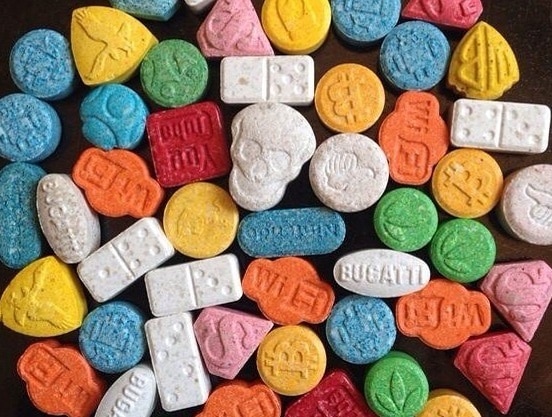Ecstasy/MDMA Addiction and Abuse
Ecstasy is a synthetic drug that in all actuality is MDMA which stands for 3, 4- methylenedioxy-methamphetamine. It influences the users perception and works as a stimulant and hallucinogen as a psychoactive drug. It increases ones emotional sensitivity and energy. The neurotransmitter serotonin is the main chemical released from the brain while on ecstasy which causes an elevated mood for a short time period. It is also an antidepressant, but just for a short time. It is easy to become dependant on ecstasy/MDMA because the experience after taking the drug gives the user feelings of heightened emotional sensitivity and feelings of happiness, many times for the individual, taking ecstasy is associated psychologically as a positive experience. The more an individual is abusing the drug, the easier it is for an addiction to begin. MDMA/ecstasy releases serotonin in the brain, and when the drug is not being taken the individual can experience long periods of negative thoughts or depression. The depressive state causes the individual to seek out and take more of the drug. When people continue this use after time it makes the happy feelings stronger and because of this the individual typically wants to stay high so to not experience the negative thoughts associated with the “come down”.
Ecstasy/MDMA has such a physical and psychological grip on the user, it is a very powerful drug that has caused many people to be dependant on the drug. The only way to overcome addiction is with a proper drug treatment program. If you think that yourself or a loved one may be addicted or abusing ecstasy, at The Best Treatment Center we can help. Continue reading to see the dangers of addiction to ecstasy and learn how you can get help.
What is Ecstasy/MDMA?
MDMA/ecstasy typically comes in a powder or pressed into a tablet. It is very different from the similar drug which it is often confused with, called “Molly”. Ecstasy comes in all different colors and sometimes the tablets resemble candy or vitamin shapes. Molly is very different in form, it typically looks like small rocks or rock candy crumbles in a variety of colors as well ranging from purple, pink to white. They produce similar effects but Molly is much easier altered than ecstasy because of the form.
Ecstasy/MDMA is known to increase activity in the following three brain chemicals: norepinephrine, dopamine and serotonin. Norepinephrine increases blood pressure and heart rate in an individual. Dopamine is known for increased energy and making someone feel euphoric. Norepinephrine increases a person’s heart rate and blood pressure. Serotonin evevates an individuals mood and increases their emotional closeness with another on an interpersonal level, this also leads to a higher sex drive, and also keeps people awake and unhungry. MDMA high takes off quickly after taking the drug, usually it takes about 15 or so minutes for it to travel through the bloodstream and hit the brain. The high effects of ecstasy/Molly last anywhere from three to six hours.
Street Names for Ecstasy/MDMA
Ecstasy/MDMA are illeagal drugs, so there is no way to get a prescription or anything else, everyone who buys these drugs is buying them through a dealer or a common term used is “on the street”. Knowing the street names could help identify if a loved one is misusing ecstasy/MDMA.
Some of the most common street names people might hear or read on the Internet include:
Ex
XCalifornia
Sunrise
Cadillac
Beans
California
Sunrise Essence
EClarity Hug
Drug Eve Love
Drug Peace
Snow ball Lover’s
Speed Uppers
Ecstasy Addiction
There are disagreements amongst medical experts when it comes down to if MDMA/ecstasy is addictive or not. Medical experts have differing opinions on whether MDMA/ecstasy is addictive. There have been many experiments including animals (rats) that show they will self-administer the drug themselves which show signs of either a psychological or physical dependence, so this does say a lot about the potential for addiction but especially high levels of abuse. It is less addictive than cocaine and meth, so that is why there are disagreements on how dangerous addiction is. When the withdrawal symptoms come after use, it affects each individual on different levels.
There are many people who have reported to have withdrawal symptoms after using ecstasy/MDMA, but the levels of addiction in each drug vary to some degree. Each person also responds differently to each kind of drug, so where as someone may be more addicted to cocaine than they could ever be off of ecstasy, whereas others could only want to take ex. While the level of addiction for ecstasy/MDMA is unclear, many medical experts do not recommend taking the drug frequently or in larger doses. Just like any drug this is a sure sign to a problem that starts with abuse and turns to addiction quickly. When you are using the drug nonstop, there is no arguing addiction is present. There is also a risk for overdose when taking MDMA/ecstasy because of each mix may have other filler chemicals and this is always dangerous and sometimes lethal.
Signs, Symptoms and Effects of Ecstasy Addiction
If you or someone you know may be struggling with an addiction to MDMA/ecstasy, it is important to know the common signs and symptoms on both a behavioral and physical level. It is also common to abuse ecstasy/MDMA with other drugs such as marijuana and alcohol. MDMA as previously mentioned above, increases closeness and trust within individuals, some individuals will abuse this drug with Viagra for an increased sex drive or new sexual experience. It has caused some users to be increasing more sexually active and promiscuous or engaging in sexual acts with multiple partners, so unsafe or risky sex practices. Since MDMA increases trust and closeness for people, many pair it with sildenafil (Viagra) for an increased sex drive and unique sexual experiences. If someone suddenly starts taking Viagra, either with or without a prescription, this is a potential sign of ecstasy misuse, especially if they have reported becoming more sexually active and with numerous partners.
Behavioral Changes Caused by MDMA/Ecstasy Addiction
Drug use can be very behaviorally obvious when it comes to the abuse of MDMA/ecstasy. The use will typically start when an individual starts hanging out at a new party spot or meets a new group of friends. Noticing these changes can really help determine if yourself or a loved one can be struggling with MDMA/ecstasy abuse or addiction. Notable behavioral changes of ecstasy use are, (can also be compared to any drug addiction):
Sudden loss of interest in passions, activities or hobbies
Hostile mood
Sleep disturbances, sleeping in more, or staying up all night
Poor or declining performance at work or school
Uncooperative attitude

Physical Effects of Ecstasy/MDMA Abuse
During the withdrawal process from MDMA/ecstasy is when the physical effects will be easiest to see.
Depression
Insomnia
Irritability
Sleepiness or fatigue
Aggression or impulsive behaviors
Memory loss
Concentration problems
Lack of appetite
There are many psychological effects from the drug as well, these include depression and anxiety. It is easy for individuals struggling with these mental health concerns to turn to ecstasy as a way to self medicate because of the positive feelings and happiness produced from taking the drug.
It is actually more harmful than good though, because during the withdrawal process the body does not produce enough serotonin and instead is overwhelmed with negative thoughts and emotions.
Risks and Dangers of Ecstasy Addiction
Above we mentioned all the negative side effects of ecstasy use and addiction. It was physical, psychological, and behavioral. There can be negative risks associated with social interactions, relationships with family, career and school issues, drug use inhibits every aspect of an individual’s life. These are all awful, but it can be so much worse. The dangerous side of ecstasy is when in high doses it can affect the body’s ability to regulate body temperatures. If this happens, individuals can have damage done to their kidney, liver, or have heart failure, overdose can even lead to death. So if you or someone you know is struggling with ecstasy or MDMA addiction, the time to get help is now.
Ecstasy/MDMA Treatment at The Best Treatment
Ecstasy/MDMA treatment is available throughout the country. The first step is admission to the problem after that you just need to locate an appropriate rehabilitation program to fit your unique needs. There are many co-occurring disorders that can result from misuse of ecstasy/MDMA. At The Best Treatment Center we provide co-occurring disorder treatment programs so we know each individual will be able to leave our care without turning to the use of drugs or alcohol.
Addiction Treatment for ecstasy/MDMA from The Best Treatment Center comes with intense therapy sessions including individual and group settings, education on the disease of addiction, EMDR trauma therapy, cognitive behavioral therapies, relapse prevention and more. The PHP and IOP levels of care provided by The Best Treatment is important because in order to prevent relapse it is suggested a 60-90 day rehabilitation process is completed. We offer an individualized treatment program because it is essential to begin treating the root causes of drug use and addiction and everyone’s care is different.
Our goal here at The Best Treatment Center is to support our guests during their recovery journey and always encourage their continuous growth. We know that the more supported our guests feel, the more courage they will have to continue in their battle against a ecstasy/MDMA addiction.

